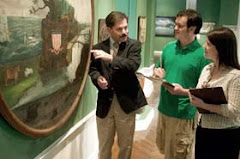Upon the introduction of photography to the United States in 1839, the daguerreotypy became closely associated with folk art. Painters such as Erastus Salisbury Field and Isaac Augustus Wetherby, even dabbled in the new art form of creating likenesses. According to Floyd and Marion Rinhart, “the charming simplicity of American primitive art exerted a powerful influence during the daguerrean era, especially in its first decade.”
Then what messages are conveyed when daguerreotypes depict folk art, as in the image of Field's 1840s portrait of a woman, seen above? There is no single answer to this question. Today, motivations are often indiscernible due to the ambiguity of daguerreotypists, folk artists of depicted works, and intended viewers of each individual piece. Some conclusions, however, are perceivable after scouring numerous primary and secondary sources, as well as studying several folk art daguerreotypes that were recently on the market. Folk art was reproduced in daguerreotypes for both public and private viewing, for reasons of commemoration, advertising, and insurance. The common denominator of these attributes is visual documentation.
.
A daguerreotype of Asa Ames (above) depicts the folk sculptor in an occupational setting. The image shows recent projects completed by Ames, including a carved baby dated June, 1849. Ames was known to have sculpted friends and family in his short career. It is possible that Ames is advertising his business in a tongue-and-cheek family portrait setting.
Folk art paintings, in particular, were often depicted in daguerreotypes. Paintings did not require a large amount of skill and choice on the part of a daguerreotypist to reproduce them. The best way to capture a successful likeness of a painting was to position it squarely in front of the camera in an environment with equal, diffuse lighting to prevent glare.
In the 1840s and 1850s, there was a large public demand for photographs of deceased relatives; thus, it was common to reproduce daguerreotypes of the deceased and distribute them to family members. For those who had lived before photography, their likenesses would have been in the form of paintings.
Innovation was a common theme commemorated in daguerreotypes of folk art. A painting of the New World attributed to J.J. Bard (above) and a weathervane of the Brookline locomotive (below) pay homage to the wonders of steam power and sensationalism in the United States. The New World was launched from New York harbor by Captain Ned Wakeman and his armed crew after a creditor’s lien was placed on the boat. The boat traveled from New York around the Horn to San Francisco. The Brookline locomotive was originally named “The Lion.” Built in 1835, it was the first locomotive to travel the Brookline Branch Railroad in Massachusetts. The locomotive was updated in 1853 to a 4-2-2 type and renamed the Brookline. The weathervane was most likely made in response to this event.
In sum, the motivations behind daguerreotyping folk art were specific to owners of the original artwork and the intended viewer of the reproduction. These motivations do, however, fall into categories of commemoration, advertising, and insurance. Daguerreotype reproductions of folk art serve as visual documentation of a by-gone era.
-by Laura Laubenthal, American Folk Art course, Cooperstown Graduate Program

















